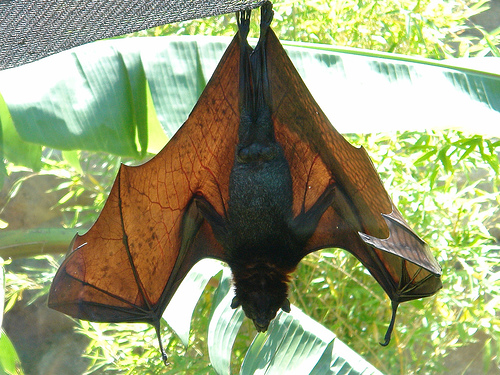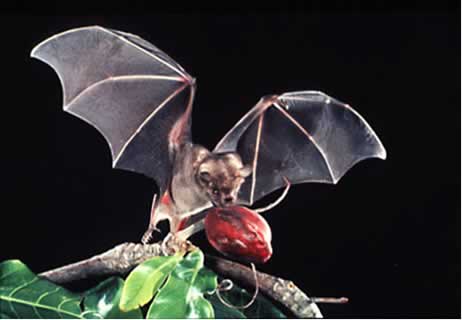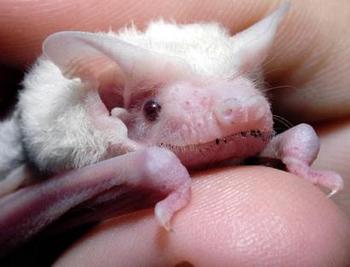
Mammalian Aviators
There are nearly 1,000 species of bats in the world, which amounts to approximately a quarter of all mammal species. They are found everywhere except in the most extreme desert and Polar Regions. Bats are the only mammals that are capable of sustained flight. All bats fit into one of two groups, the Microchiroptera (typical bats) or the Megachiroptera (flying foxes). The flying foxes are named for their fox-like faces and are found only in the Old World tropics.

Bats are highly varied in appearance and size. Some have long, angora-like fur, ranging in color from bright red or yellow to jet-black or white. One species, the naked bat, is furless while others are so brightly patterned that they are known as butterfly bats. Others have enormous ears, or leaf-shaped noses, or intricate facial features, which play a sophisticated role in navigation. The bumblebee (or hog-nosed) bat of Thailand, weighing one-third the weight of a penny, is the world’s smallest mammal. In contrast, some flying foxes have wingspans of up to six feet.
Seventy percent of all bats are insect eaters. A few tropical species feed exclusively on fruit or nectar. Others are carnivorous, feeding on small vertebrates such as fish, frogs, mice, and birds. Vampire bats, of which there are three species, feed exclusively on blood. Bats are beneficial in that they play essential roles in keeping populations of night-flying insects in balance, including mosquitoes. In the tropics, the seed dispersal and pollination activities of fruit- and nectar-eating bats are vital to the survival of rain forests, with some acting as keystone species in the lives of plants crucial to entire ecosystems. For example, only bats pollinate the Baobab tree of African savannahs, which is often referred to as the Tree of Life because it is so important to the survival of numerous wildlife species. In the Old World tropics alone, more than 300 plant species are known to rely on the pollinating and seed dispersal services of bats.

Among the slowest reproducing mammals on earth, bats average only one young per year. But they are long-lived, with some surviving for more than 34 years. Some tropical bats engage in elaborate courtship displays. Male epauleted bats sing and flash large fluffs of white shoulder fur to attract mates. Male crested bats perform a spectacular display by expanding long hairs on top of the head similar to a peacock spreading its tail.
Bats are not blind, and many have excellent vision. Like dolphins, most bats navigate by echolocation, which involves the use of high-frequency sounds. Using sound alone, bats can "see" everything but color. In echolocation a series of short, high-pitched sounds are emitted. These sounds travel out away from the bat and then bounce off objects and surfaces in the bat’s path, creating an echo. The echo returns to the bat giving it a sense about what is in its path. This echolocation system is so accurate that bats can detect insects the size of gnats and objects as fine as a human hair.

Just as the bat’s echolocation shows it what is in its path and guides it safely through the darkness, so the Word of God guides the Christian in the path he should follow in this world of sin and darkness. "Thy word [is] a lamp unto my feet, and a light unto my path." Psalm 119:105. "This book is God’s great director. . . . It flashes its light ahead, that we may see the path by which we are traveling . . . ." My Life Today, 27. "The path where God leads the way may lie through the desert or the sea, but it is a safe path." Patriarchs and Prophets, 290.
David Arbour
- Home
- Days Of Long Ago
- Farmer
- Cougar
- Three Men
- Dog
- I Will Return
- Esther
- Joseph Bates
- Martyr
- Courage And Strength
- The Dark Cloud
- A Prayer In The Dark
- Sabbath Of The Lord
- Kingly Shepherd Boy
- Man In The Philippines
- Heart Searching
- Companion In Trouble
- Book
- Willie
- Jonah
- Kitten and Cobra
- From Above
- Preacher A Thief
- Jolanta
- Glass Of Milk
- Dangerous Ice
- Marge
- Train Wreck
- Happy Family
- Beware
- What Next
- Revenge
- Preacher
- Thankful
- Angel By Me
- One Cord
- The Record
- Decision
- Susie Prayer
- Company Manners
- Company
- The Ballroom
- Make Plain
- Christ Our Refuge
- Slaughter
- Toms Trial
- Premium
- Caravan Starts
- Kind Word
- Another Commandment
- Retired Merchant
- Novel Reading
- Just Before Generous
- Quicksand
- Light In Darkness
- What Shall Profit
- Within Your Means
- Wrong Pocket
- My House Our House
- Mountain Prayer Meeting
- Rescue At Sea
- Only A Husk
- Ruined
- Was Blotted Out
- Never Indorse
- A Life Lesson
- Hard Times Conquered
- Good Lesson Spoiled
- Prayer For Pirates
- Grandmothers Room
- School Life
- Benevolent Society
- Instructive Anecdote
- Didnt Smoke
- Scenery Trip
- The Young Musician
- Lymans Testimonial
- Unforgotten Words
- Herrings For Nothing
- Bread Upon The Waters
- Miracles In Africa
- Rift In The Cloud
- Reward Of Perseverance
- Ricest Man
- Over The Crossing
- Mother Prayer
- Fence Story
- Drugs And Why
- In My Place
- Infidel Captain
- Jewels
- Nellie Altons Mother
- Dangerous Doors
- Heart Has Sorrow
- The Open Door
- Weeping
- Evening Prayer
- Happy New Year
- Rowena And Pills
- Scripture Quilt
- Speak To Strangers
- The Lost Bag
- Fire
- The Majors Cigar
- Creation Story
- Little Sisters
- He Stood The Test
- Widows Christmas
- A Will Joe
- Large Oak Tree
- Scene In A Saloon
- Look To Your Thoughts
- Andys Hands
- For Whom
- Infidels Converted
- The Perfect Helper
- Arrested For Christ
- Twenty-Three Miles
- Left To Die
- Boy Of New Guinea
- Winifreds Party
- Fjord And Ferry
- Working With Him
- Clock Struck Thirteen
- Kant And The Robbers
- Can And Could
- Wormy Puffball
- Neds Trust
- King Snakes
- Maggies Lost Cat
- Act Of The Will
- Home For Harry
- Set Free
- Door To Door
- Hard To Reach
- Reaching A Muslim
- Bears
- Bushman story
- Milk Pan
- A King Is Born
- Hailstorms And Horses
- The Unbeliever
- Man With A Past
- Disarming Dog
- Broken Bone
- Angel Over Tent
- Cow Got Stuck
- Brave Girl
- Boat And Raft
- Battles
- Taking My Picture
- Moderation
- Miss Clancy
- School
- Golden Gate
- Morning Star
- All The World
- Mountain Children
- Six Years Old
- Greatest Gift
- God's Love In Affliction
- Zacchaeus
- Letter From China
- Angel Hand
- Angry Mob
- A Daughter's Prayer
- Deliverance
- Dog That Watched
- Footprints In Snow
- Prayer Of Faith
- Urgent Voice
- Watchmen
- Where's Your Friend
- Never Give Up
- By The Window
- Little Lamb
- Sea Stars
- Good Foundation
- Wandering Glider
- Tough Roots
- Trust Jesus
- Build A Bridge
- Oilbirds
- Potatoes
- Honeybee
- Stormy Night
- Shabbat In Lvov
- Hospitality
- Alone With Wolves
- Elephant Lifesaver
- Angel's Hand
- Angel On Patrol
- In The Night
- Sierras
- Someone Helped
- Mission To Portland
- Food From Heaven
- Sticky Situation
- Taking The Bite
- Soldier For God
- Beriberi Good Discovery
- Who Is King
- Rescuing Uncle Nat
- Modest Abe
- In The Mist
- Baton Rouge
- Baby Craze
- Miracle Water
- Out Of Control
- The Back 9
- The Bull Preached
- Speed Toward Trouble
- Miracle In Boston
- Bandits In The Night
- Nailed
- Arrested For Jesus
- Dog Sold A Book
- Enemies
- My Shoes
- Kidnapped
- Emergency
- Money Trouble
- Friends For Real
- Prickly Revenge
- Paper Carrier
- Baby Elephant
- Silent Culprit
- Triple Blast
- Strange Idea
- Seven Apples
- Crack In The Wall
- Miracle For Melianne
- Meet My Brothers
- In The Field
- Jellyfish
- Greetings From Florida
- Trapped In An Oven
- Outnumbered
- Kingdom Of Ants
- Rustlers
- Cornmeal Answer
- Awakened By Rattlesnake
- Meerkats
- Christmas Plan
- Stampede
- Saving Twins
- Dead Man Talk
- Hurricane Warning
- Treasure In Wales
- Test Of Faithfulness
- Fernando Stahl
- Grouchy Mrs C
- Behind Enemy Lines
- Buried At Sea
- Miracle In The Surf
- Charming Nancy
- Mountain Of Fear
- Trail To Freedom
- Forbidden Village
- Leather hat
- Midst Of Danger
- Jungle Missionaries
- Bluebells
- Call To Kayata
- Gossip Story
- We Have Hope
- Kindness Repaid
- Cuttlefish
- Rescued
- Little Child
- The Potter
- Hands
- Willie's Story
- Kindness Of A Stranger
- Kindness Pays
- My God Hears
- Freedom's Shore
- Light In The Darkness
- Robbers Repent
- Datu's Dream
- Helped By An Angel
- Freedom In Jesus
- Peace In Jesus
- Convert
- Changed Heart
- A Child's Song
- Fasting
- Escape
- God's Money
- Vision Of Love
- Just A Minute
- From A Friend
- Power Of Influence
- Bouquet Of Gods Love
- Divine Love
- Caught By Christ
- God's Wings
- Little trees
- Stuck In The Closet
- Mad Dog
- Lone Flight
- Becky's Flowers
- Drummer Boy
- Crossing The Street
- Fire Chief
- Clock Struck Ten
- Earthquake
- Sold
- Where's The House
- It's Broken
- Rain And Flood
- Vacation Brakes
- The Very Smallest
- Angel Power
- Delayed Not Denied
- Two Chairs
- Count And The King
- No Theology Degree
- How The Prophet Felt
- Unsharpened Knife
- Horse Sense
- Prayer Is Real
- Learn Instantly
- Little Indian
- Heaven's Guard
- In Advance
- Three Dreams
- Father Knows Best
- Voice Of An Angel
- Across The World
- Without Leaving Home
- Tiger On The Trail
- Sharpened By Sword
- The Unseen
- Shoe Repair Shop
- Telegraph
- Two-Week Hideout
- Liberty
- King And The Girl
- Busy Spider
- Dogs And More
- Brave Man
- Protecting Hand
- Lost Carabao
- Poisoned In Tibet
- She Loved Her Lord
- The Letter
- Angel In A Boat
- Believing Prayer
- Touch Of Angel Hands
- So Many Lights
- An Ant Did It
- Big or Little
- How Much Water
- Shingles
- Miracle In India
- Night Visitor
- Without Realizing It
- Six Little Girls
- Home Invasion
- Only One Key
- Thunder At Eight
- Credentials
- In The Fire
- Grace
- Fire Inferno
- Gave Mother A Message
- Granny Gets Baptized
- Kirkland
- All She Suffered
- Chinese Adventures
- Twice Delivered
- Africa
- Labor Of Love
- Map On The Wall
- New Year Connecting
- Gentle Giant
- A Prisoner
- Prayer
- God's Power
- Raised Spear
- New Church
- Exciting Work
- The Great Physician
- Track Indians
- Perseverance
- Honest Confession
- Delivered From Alcohol
- The Wanderer's Prayer
- Singular Will
- Inspiration In My Work
- Ears That Hear
- Stepmother
- Colporteurs
- When Mother Is Gone
- Expected Miracle
- God Is Not Mocked
- Survive A Freezing River
- Hell On Earth
- With The Green Cover
- Bad News
- The Stowaway
- Power In God's Word
- Grandfather's Faithfulness
- Foes Or Friends
- Challenged Me
- Deadly Combination
- Face Death
- Journey To Happiness
- Keep It Holy
- Animal For Children Story
- Almost
- Hand Of God
- Never Let Go
- Could Have Been An Angel
- God And The Spider
- A Plucky Boy
- Strange Mechanic
- This Moses Was Black
- Relay For Life
- Angel Of Mercy
- Thanksgiving
- Buzzing Sounds
- Paid A Debt
- Morpho Butterflies
- Crutches On The Alter
- One Boy Did
- Don't Get Burned
- Save The Bibles
- Basket Of Coal
- Autumn Leaves
- Carl's Garden
- Courageous Visitor
- Miracle In The Mountains
- Amazing Orchids
- Good Neighbor Policy
- The Lord Will Provide
- Isaiah 53 5
- Playing For The King
- One Minute More
- Small Corners
- Surprise Package
- Child Shall Lead Them
- Guards Of The Lord
- The Winds Blow
- Snapping Turtle
- Three In A Row
- Tweety
- Coals Of Fire
- Chicken House Snake
- Love
- The Kinds Of Bears
- Moses The Cat
- Lost Not Forgotten
- Feathers
- Missionary Spirit
- Emperor Penguin
- The Brown Towel
- God Will Take Care
- A Prayer Weighs
- The Golden Windows
- Worship The Devil
- Myrmecophytes
- To Be Caught
- Tree Frogs
- Feathered Jewels
- Called To The Light
- Baby Duck
- The Big Six
- Birthday Card
- Rescue At Night
- Fish Cleaning
- Fishing
- Dragons
- Chain Gang
- Troglomorphic Fish
- Mother's Love
- Mammalian Aviators
- Ocean Giants
- Tom's Revenge
- God Is Seen
- Spare Moments
- Shorebirds Talents
- Cobra In The Closet
- God Made Me Too
- The Choice
- Shining Face
- Taking Aim
- And I Wept
- Latchkey Was Out
- God Made Wonders
- The Kitten
- Don't Go To Church
- Rajeshwari
- Manna From Heaven
- Red Marbles
- Attractive But Deadly
- Boardman's Deliverance
- Escape By Prayer
- Deliverance Of Clarke
- God's Mercy
- Does A prayer Weigh
- Something Better
- Make An Overpass
- Laddie The Leader
- Book Mobile
- Shut Up With A Bible
- Tripped By An Angel
- Martyr's Mirror
- Muriel's Bright Idea
- The Ship's Crew
- A Stormy Night
- Strength Of Clinton
- Three Stages
- Trapped
- A Favorite
- Mother's Day Disaster
- The Little Latchkey
- Stuck On The Mountain
- Learned To Pray
- Faith That Never Dies
- On The Road
- Martyrs For Jesus
- Errand Boy
- Killer Bees
- Beautiful Farm
- Put To Flight
- Hurricanes
- Relief Of Leyden
- The Christian Dog
- Angel Report
- Persecutor To Persecuted
- Charles Tells His Story
- Love Story
- Grandma's Birthday
- Prepared Heart
- Revolution
- Lady In Japan
- Bandidts
- Lightening
- By Tempest
- Pray To Jehovah
- Elements Overrule
- Widow And The Priest
- Turning The River
- Trusting Jesus
- Happy Home
- Mad Elephants
- One Black Spared
- Christian Mechanic
- Bible And Magic
- Children Poems
- Siberia
- Stories
- Narrow Escape
- Interposition
- Pushed The Car
- Tennent In A Trance
- Have A Nice Weekend
- What Love Can Do
- Angel's Work
- Forbidden Book
- Jimmy And Grandpa
- Katie's Tongue
- Mabel's Dream
- Maple Syrup
- The Long Road
- Things That Spread
- Love Your Enemies
- Vision
- Boy And His Boarder
- Dog Saved A Crew
- Prison Door Open
- A Boy Lived Again
- God Chose One Weak
- Anne Askew
- Zinzendorf
- Hottentot Boy
- Cry For help
- Livingstone
- Elements Work
- Fugitives Delivered
- Forsaken Idol Tree
- Chinese Heart
- Out of Darkness
- Steps Of Faith
- Get The Captives
- Help In Formosa
- In Pondoland
- Boxer Uprising
- Basuto Raiders
- Flash Of Lightning
- Providential Gale
- Deliverance In Nicobars
- Restraining Hand
- Friends For Jesus
- Special Project
- Did Not Laugh
- Radio Station
- Run To Church
- Curious Carla
- Mango Tree
- Louisa's Lunch
- Red Motorbike
- Refuse To Pray
- Mopane Tree
- No Longer Bored
- Runaway Goats
- Letter From God
- Sad Little Duku
- Basile's Discovery
- Singing Band
- Boy's Witness